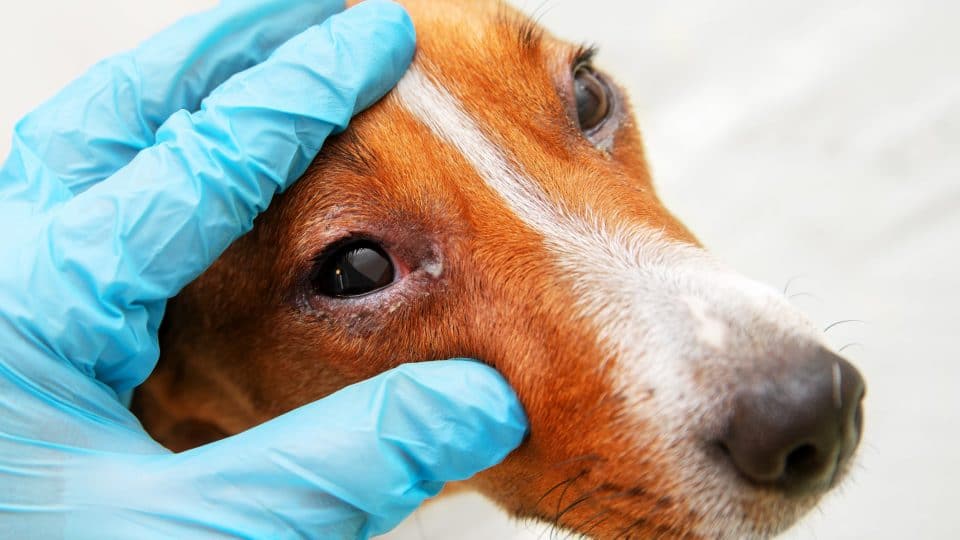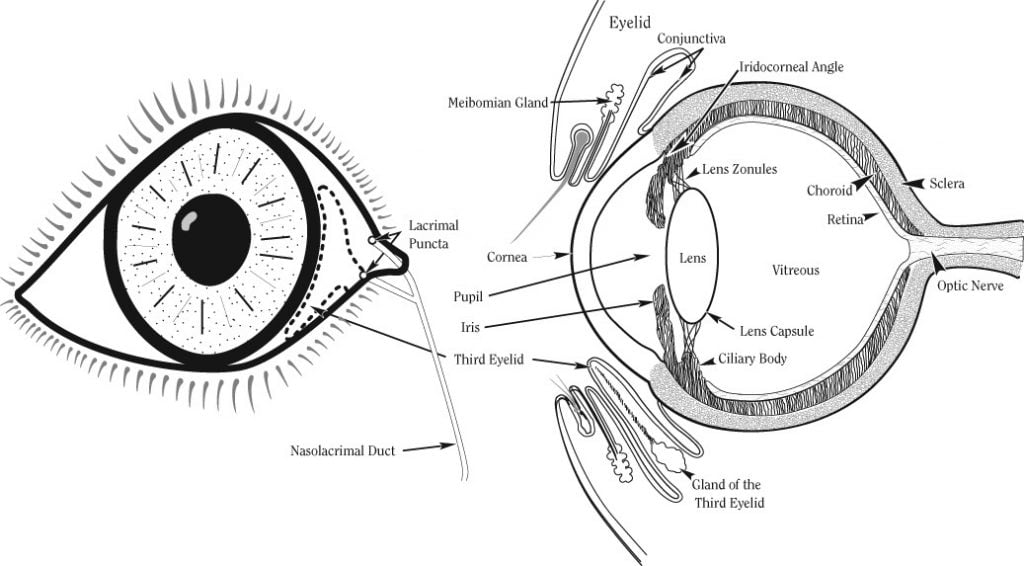My Dog Has Eye Infection What Should I Do
- This review contains affiliate links. Read more here.
- Not a substitute for professional veterinary help.

Hugo1313 via iStock
Eye infections can occur in your dog when you least expect it—and they may be difficult to spot. When you notice redness or discharge in your dog's eye, how can you tell if it's allergies, an infection, injury, or irritation? As a veterinarian at the University of Southern California, I'd like to share with you how to spot thesigns of a dog eye infection, along withcauses,treatments, prevention,and when to see your vet.

This eye solution for dogs is made with boric acid to gently reduce eye irritations and flush out debris.
Shop on Amazon
Common signs and symptoms of an eye infection in dogs include:
- Redness:the eye appears pinker or redder than normal
- Discharge:varies with the type of disease
- Clear discharge is usually the cause of viral infections or allergies
- Mucoid to mucopurulent (cloudy or yellowish) discharge could be dry eye disease
- Purulent or thick yellowish-green "pus" could be a bacterial infection
- Squinting:increased blinking or spasms of the eyelid or light sensitivity
- Pawing at the eye:can indicate itchiness or pain
- Swelling of eyelids:one or both eyelids look puffy
You will usually see multiple signs occur at once, like a red, squinty eye. This is because if the eye is infected with bacteria then the immune system will react with inflammation (discharge, redness, and/or swelling), which can also be painful (causing pawing and squinting).
Dogs with allergies, a corneal ulcer, dry eye, or trauma could look similar to this, so it's important to have your dog undergo a complete ophthalmologic exam if you're concerned.
There are two main causes of dog eye infections:viralandbacterial. Bacterial is far more common. Bacterial eye infections are caused by unicellular microscopic living organisms and usually need an opportunity to infect the eye. Viruses (infectious agents made of protein and nucleic acid), trauma to the eye, or dry eye disease, can provide the perfect opportunities for bacteria to invade and grow because there is a compromise in the local defenses of the eye.
A dog's eyes do an excellent job of self-cleaning with the tear film. Thus, when bacteria contaminate the eye, it's rarely due to the bacteria alone and probably related to something compromising the eye's integrity.
The most common cause of eye infections in dogs is a bacterial infection resulting from an injury, like a scratch or ulcer on the eye. Many times a dog will get scratched in the eye by a claw or in rough play and the wound on the cornea (the transparent layer forming the front of the eye) gets infected with bacteria that prevent it from healing. You'll see your dog squinting from the pain but usually, you won't see the wound itself.

Bacterial infections can also result from unwelcomed visitors entering your dog's eye. Foreign bodies such as fur or hair sticking into the eye can sweep bacteria into the eye, causing an infection. Other foreign bodies include dust, debris, or plant material. These items can get lodged under your dog's third eyelid (the dotted T-shaped organ in the diagram above) and cause irritation and infection unless removed.
Eye abnormalities that can predispose your dog to bacterial infections include eyelids that turn inward or outward (think Basset Hounds), eyelash irritation, or tumors of the eyelid. Abnormal tear film can also predispose a dog to bacterial infections as well as dry eye.
Canine distemper virus can cause a viral eye infection. Viral infections are usually self-limiting unless accompanied by a secondary bacterial infection.
As a dog owner, you don't need to be worried about viral infections if you get your dog regularly vaccinated. Viral infections in the eye can look like bacterial infections eventually, but with viral infections, you might notice other additional signs also such as lethargy, nasal discharge, and a fever.
You can provide supportive care at home to help with your pet's comfort level.
Home remedies such as non-medicated sterile saline rinses can flush the eye but are only a short-term solution if your dog already has an infection. Saline rinses are a good idea if you're seeing just a little clear discharge and a little redness. It's importantnot to use human eye drops or medications as dogs can have adverse reactions to these human medications.
I recommend either Tomlyn Sterile Eye Wash for Dogs and Cats or Nutri-Vet Eye Rinse Liquid for Dogs when flushing a dog's eye at home. Be sure to use a clean cotton ball after rinsing to catch and wipe the drainage. Refrain from touching the eye with the nozzle tip, your hands, or the cotton ball.

This eye solution for dogs is made with boric acid to gently reduce eye irritations and flush out debris.
Shop on Amazon
You can also use a warm, moist towel to gently clean discharge from the corners of your dog's eyes and facial area.
If you've eliminated the possibility of eye infections in your dog but don't like the unsightly tear staining that's a normal part of eye discharge, you can give your dog Angel's chews to minimize the staining on the face.
What if Something Is Stuck in my Dog's Eye?
Removing a foreign body from your dog's eye may have some risks involved.
If you can see that it's easily removable without causing your pet any additional pain or further injury, for example, a loose hair, then this is fine for you to remove. If the object is something larger and potentially injurious, removal may require special tools or sedation, which should be done at the vet's office.
If you continue to see signs of irritation, swelling, and redness after rinsing your dog's eye, then it's time to see your veterinarian.
After performing an ophthalmic exam and some specific eye diagnostics, your vet may also prescribe topical antibiotics for you to administer to your dog if she suspects a bacterial infection. These will be relatively easy for you to administer at home.
Since dogs are often playful and energetic in environments with opportunistic organisms, preventing eye infections can be difficult. One prevention method is to carefully trim the longer hairs around their eyes to prevent constant irritation of the hair in their eyes. If you don't feel comfortable doing this yourself, you can ask a professional groomer.
If you go hiking with your dog or trek to the desert, you could consider having him or her wear dog goggles, such as those made by Doggles, which protect the eyes from UV light, dust, and plant fibers.
Eye infections in dogs are very treatable and can be easily identified using the criteria listed above. If you have concerns or questions regarding your dog's eyes, these can be addressed by your veterinarian.
While your dog may prefer his nose to see the world, the eyes give an important window into his health, too.
- Dog Eye Gunk—What It Is, How You Should Clean It, and When to Get Worried
- Take a Clear Look at the Best Dog Eye Wash
- Are Dogs Color Blind? All Your Questions about Dog Eyesight, Answered
Dr. Ari Aycock-Williams is a board-certified, licensed, and USDA-accredited veterinarian. She earned her Doctor of Veterinary Medicine degree at Michigan State University in 2009. Dr. Aycock-Williams went on to complete her residency and certification in Laboratory Animal Medicine at the University of Southern California. Currently, she is the Senior Clinical Veterinarian at USC in the Department of Animal Resources.
My Dog Has Eye Infection What Should I Do
Source: https://www.rover.com/blog/reviews/dog-eye-infections/
0 Response to "My Dog Has Eye Infection What Should I Do"
Post a Comment